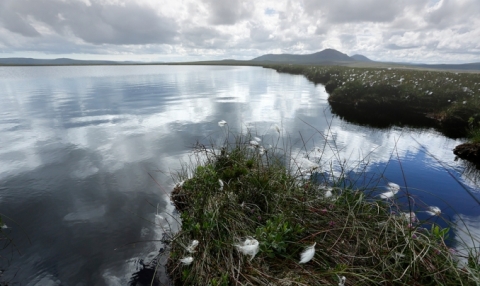Scotland's Flow Country, Europe's largest peatbog to apply for Unesco World Heritage status

The Peatlands Partnership has had approval to prepare a bid for UNESCO World Heritage Site status for an area of peatbog, lochs and bog pools called the Flow Country. The area stretches across Caithness and Sutherland in Scotland. The bid, if successful, would result in the special designation being in place in three years' time. A World Heritage site is a landmark or area which is selected by the United Nations Educational, Scientific and Cultural Organization (UNESCO) as having cultural, historical, scientific or other form of significance, and is legally protected by international treaties.
“The Flow Country” covers some 1540 square miles (4000 km2). It is the largest expanse of blanket bog in Europe. Blanket bog only forms in cool places with plenty of rain. The blanketing of the ground with a variable depth of peat gives the habitat type its name. The few plants that can grow here don’t rot away, but build up to form deep layers of peat. The bogs of the Flow Country have been growing for over 10,000 years, since the end of the last Ice Age, and the peat is now up to 10 metres deep.
Blanket bog covers about 20% of Scotland’s land area: some 15% of all the blanket bog in the world. The peat bog is a rich wildlife habitat and home to plants that are unique to that environment, rare birds, and distinctive species of invertebrates such as spiders and beetles. It is a breeding ground for many different species of birds as well as providing shelter for nesting birds, reptiles like frogs and snakes, and small mammals like shrews. Bogs also store more carbon than any other land-based ecosystem. This gives them an important role in the defence against the effects of climate change. They also play a major role in providing high quality, unpolluted water, making them an ideal source of drinking water.
Peatlands are one of the most important natural ecosystems in the world. However, they are under continuous threat. The Flow Country was under severe pressure in the 1980s and early 1990s. It was damaged through the planting of non-native conifer forests and the cutting of thousands of miles of drains. However, a conservation campaign mounted by the RSPB was an important factor in preventing further deterioration. The work to campaign for UNESCO World Heritage Site designation has been undertaken by a joint effort involving a number of organisations, including Scottish Natural Heritage, Forestry and Land Scotland, Scottish Forestry, Highland Council, RSPB Scotland and Plantlife International, the Environmental Research Institute UHI in Thurso, Highland Third Sector Interface, Flow Country Rivers Trust, Northern Deer Management Group and Highlands and Islands Enterprise. They combine to make up the Peatlands Partnership.
Image: Courtesy of the the flow lands website.





